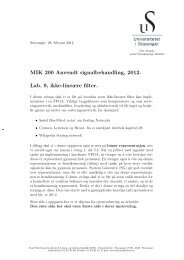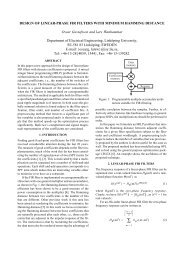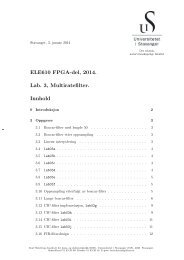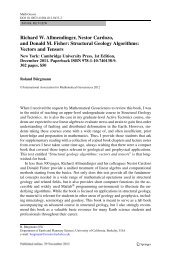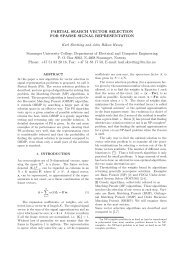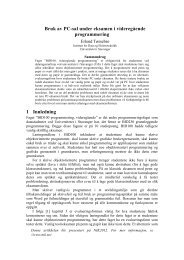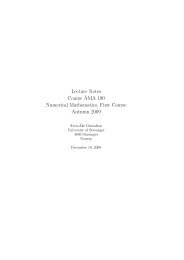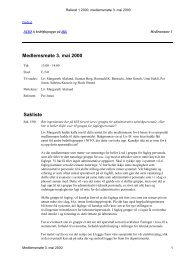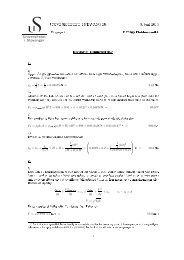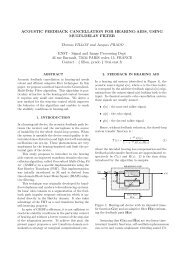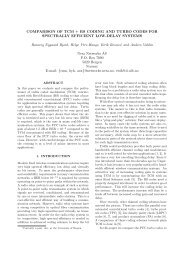MODELING OF LOW SALINITY EFFECTS IN SANDSTONE OIL ...
MODELING OF LOW SALINITY EFFECTS IN SANDSTONE OIL ...
MODELING OF LOW SALINITY EFFECTS IN SANDSTONE OIL ...
Create successful ePaper yourself
Turn your PDF publications into a flip-book with our unique Google optimized e-Paper software.
<strong>MODEL<strong>IN</strong>G</strong> <strong>OF</strong> <strong>LOW</strong> <strong>SAL<strong>IN</strong>ITY</strong> <strong>EFFECTS</strong> <strong>IN</strong> <strong>SANDSTONE</strong> <strong>OIL</strong> ROCKS 114.1. Simplifying assumptions. Before we proceed some simplifying assumptions are made:• The oil and water component densities C o and C are assumed to be constant, i.e., incompressiblefluids;• The effect from the water-rock chemistry in the water phase equation (second equation of(38)) is neglected which is reasonable since the concentration of the water phase C is muchlarger than the concentrations of the ion exchange involved in the chemical reactions;• Constant porosity ϕ, absolute permeability κ, viscosities µ, µ o ;• One dimensional flow in a horizontal domain.• Capillary pressure is currently neglected as discussed in the introduction (Section 1.2).This results in the following simplified model:(39)∂ t (ϕs o ) + ∂ x (V o ) = 0,∂ t (ϕs) + ∂ x (V ) = 0,∂ t (ϕsC na ) + ∂ t (M c β na ) + ∂ x (C na V ) = ∂ x (D(ϕ, s)∂ x C na ),∂ t (ϕsC cl ) + ∂ x (C cl V ) = ∂ x (D(ϕ, s)∂ x C cl ),∂ t (ϕsC ca ) + ∂ t (M c β ca ) + ∂ x (C ca V ) = ∂ x (D(ϕ, s)∂ x C ca ),∂ t (ϕsC so ) + ∂ x (C so V ) = ∂ x (D(ϕ, s)∂ x C so ),∂ t (ϕsC mg ) + ∂ t (M c β mg ) + ∂ x (C mg V ) = ∂ x (D(ϕ, s)∂ x C mg ).In view of (28) and (29) in a 1D domain, we get(40)(41)V = − κλp x , λ(β ca , β mg ) = k(β ca, β mg )µV o = − κλ o p o,x , λ o (β ca , β mg ) = k o(β ca , β mg ),µ oMoreover, capillary pressure P c is defined as the difference between oil and water pressure(42) P c = p o − p,and is assumed to be zero in the following. Total velocity v T is given by(43)where total mobility λ Tv T := V + V o = −κ(λp x + λ o p o,x ) = −κλ T p x ,(44) λ T = λ + λ o ,has been introduced. Summing the two first equations of (39) and using that 1 = s+s o , implies that(v T ) x = 0, i.e., v T =constant and is determined, for example, from the boundary conditions. Fromthe continuity equation for s given by the second equation of (39) it follows (since V = −κλp x )(45) (ϕs) t + (−κλp x ) x = 0,where, in view of (43),Thus,(46)−κp x = v Tλ T.(ϕs) t + (v Tλλ T) x = 0.The fractional flow functions f(β ca , β mg ) and f o (β ca , β mg ) are defined as follows(47) f(s, β ca , β mg ) :=def(48)f o (s, β ca , β mg ) :=defUsing this in (46) implies thatλ(s, β ca , β mg )λ(s, β ca , β mg ) + λ o (β ca , β mg ) ,λ o (s, β ca , β mg )λ(s, β ca , β mg ) + λ o (β ca , β mg ) = 1 − f(β ca, β mg ).(49) (ϕs) t + v T f(s, β ca , β mg ) x = 0.



